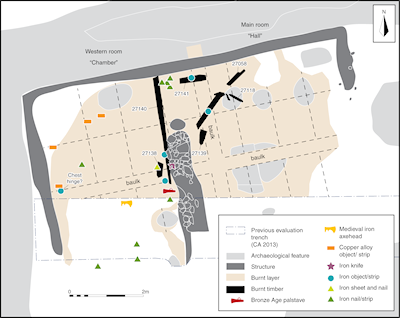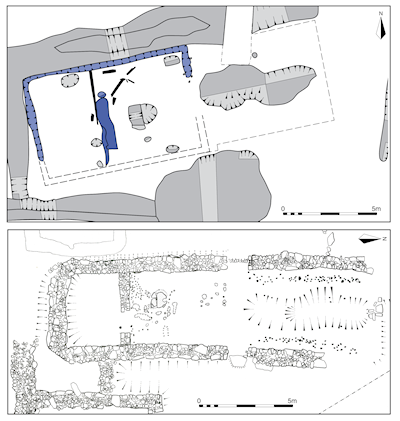

The distribution of charred material within the building has been examined in detail (see section 2.4). The interpretations of the patterning of material conform to the known medieval building tradition at this time: timber framing using a sill-beam jointed to a superstructure of roof supports and tie-beams, and walls provided by a framework of posts and rails into which woven wattle panels were sprung (Morriss 2000, 61–75). The large oak timber 27140 is readily seen as a tie-beam marking the western bay, having fallen without lateral displacement. Other oak timbers may have been beams, posts, rails or rafters. Two of them (27139 and 27141) were associated with probable dowels of ash wood (Sample 43 and Sample 45). Smaller pointed pegs from the north-west corner of the room (Sample 36 and Sample 38) were made from hawthorn/crab apple/rowan wood and, although these are of unknown purpose and seem to have been charred in an earlier fire, it is interesting to note the apparent use of specific types of wood for different objects. The large branch of poplar (less likely willow), 27058, seems to have been a structural timber, the angle that it came to rest perhaps suggesting that it was a roof rafter. It is possible that the broken length of alder, 27118, lying at right-angles, was another roof component such as a batten. The wall construction has been suggested by the consistently high percentage of oak, alder and willow/poplar from nearly all the samples along the north wall, which account for an average of 85% of the wood species from all but one of these squares. The dominance of hawthorn/rowan/crab apple in Square 10 has been mentioned as possible evidence for an internal door made of this wood. This is also the location of a group of iron nails (Figure 13) which may be related to this construction. There is also an interesting anomaly in Square 8, where a high proportion of ash appears to be at the expense of oak, perhaps indicating a different wood used in the frame here. Alternatively, the charcoal may have come from objects or furniture adjacent to the wall. At Meldon, clusters of stakeholes suggested the location of internal furnishings in two locations adjacent to the side walls and cross wall (Figure 14; Austin 1978, fig. 5). At Garrow Tor the stone furnishings included possible seats midway along the southern and eastern walls, and a 'platform' in the north-west corner (in addition to the bench on the western wall, above) (Dudley and Minter 1962, 276–7 and fig. 88).

Within the chamber, the dominance of willow/poplar in Squares 16 and 30 suggests the presence of basket containers for the crops found in those squares. The presence of beech in Squares 27 and 28 (17% and 28% respectively) may also be significant as it is largely absent elsewhere. It is possible that this relates to a chest or item of furniture here, such as a bed. It may be significant that this was the location of the iron axe-head and Bronze Age palstave (from layer 2010) and a knife and other metal items also came from this area, including possible chest fittings by the western wall (Figure 13). The chambers in manorial holdings accommodated valuables such as chests containing money, deeds and account books (Gardiner 2000, 162), and the same was true of peasant houses (Dyer 2013, 22). Inventories show that chests were sometimes made of imported wood, even in peasant houses, and could be of notable value (Dyer 2013, 25). A similar store of valuables might be envisaged here. The 'valuables' seem to have included the harvest of oats, wheat, rye, barley, beans, peas and vetches in different parts of the room. It is possible that the harvest had occupied a loft above the room, a location that may explain the combustion of this material when other wooden objects, such as those that might have occupied the ground floor, were not identifiable as such; these can be assumed to have been less completely charred and subsequently decayed. However, the concentrations of crops in individual squares perhaps counter the suggestion that they can have fallen far, as otherwise they might have been expected to have spilt more widely.
As well as the concentrations of different crops, and combinations of crops that may well have been maslin, and bulmong (harascum), there was a spread of charred vegetation that may have derived from a variety of sources. Medieval thatched roofs have been shown to contain a range of crops and weeds typical of what was harvested (Letts 2001), but the thin spread of these remains on the floor of the hall (Squares 6 to 9 and 18 to 26 - see data tables) suggests that thatch did not contribute significantly to the overall quantity of burnt material. The quantity and range of plants from the byre (feature 20736), however, is noteworthy, containing large amounts of both cereals and weeds (Sample 5). It may have been a store of fodder, or the harvest awaiting threshing, perhaps stored in a loft.
The concentration of copper-alloy scraps, and the 'cushion stone' in the chamber is also noteworthy and strongly suggests that the house was occupied by a tinker engaged in the repair of metal vessels. The Bronze Age palstave may have been collected for scrap or its usefulness as a tool, although there was no sign that it had been used in medieval times. It may alternatively have been kept as a curio or charm.
Internet Archaeology is an open access journal based in the Department of Archaeology, University of York. Except where otherwise noted, content from this work may be used under the terms of the Creative Commons Attribution 3.0 (CC BY) Unported licence, which permits unrestricted use, distribution, and reproduction in any medium, provided that attribution to the author(s), the title of the work, the Internet Archaeology journal and the relevant URL/DOI are given.
Terms and Conditions | Legal Statements | Privacy Policy | Cookies Policy | Citing Internet Archaeology
Internet Archaeology content is preserved for the long term with the Archaeology Data Service. Help sustain and support open access publication by donating to our Open Access Archaeology Fund.